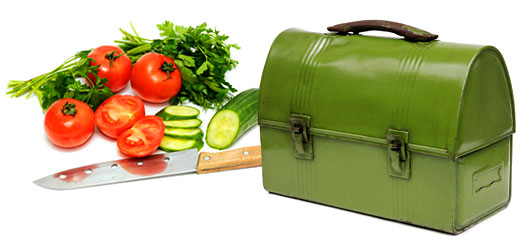
On a recent morning, I heard a report on Morning Edition that jolted my attention from an extremely delicious cup of shade-grown fair-trade organic ultra-correct joe. (Public radio and fancy coffee: see Stuff White People Like.)
The radio piece, by NPR correspondent Eleanor Beardsley, was called “In Paris, Culinary Education Starts in Day Care.” Now, as a group, Americans detest being told that any other country does any little thing better than we do here in the good old US of A. Not surprisingly, it is that very attitude that sometimes keeps us from being able to follow a good example, let alone set one. Beardsley’s segment detailed the quality of the food in the public day-care facilities in Paris, where she is stationed. It may come as no surprise, but it is considerably better in every respect than the food served in American schools.
Here is what you would never hear someone say when describing the kitchen in an American school: “A giant pot of apples and clementines simmers away on the stovetop, and cauliflower au gratin bakes in the oven.” Beardsley continues: “While [chef] Morel cuts up garlic and onions to season the braised lamb in fresh rosemary, [chef] Belot peels tomato skins to fashion decorative roses for the pasta-salad appetizer.”
Missing Kitchens
One good reason you won’t hear that description here is that most of our public schools don’t have kitchens. Food is typically reheated (as opposed to cooked) in central commissaries and trucked to the various satellite schools in each district, sometimes spending as much as 4 hours languishing in insulated hotboxes. Meanwhile in Paris, food is cooked from scratch in the kitchens inside each and every one of their 270 public day-care facilities. The ingredients, Beardsley tells us, “are more often fresh than frozen, and the chefs try to use organic products when they can.”
When he signed the School Lunch Act in 1946, President Harry Truman said, “In the long view, no nation is healthier than its children, or more prosperous than its farmers.” This statement is no doubt true, but it lent a false air to the act, which purported to be a nutrition program for the coming baby boom but instead became a boondoggle that helped to create the agro-industrial complex. The system became the dumpster in which large companies could dispose of their lowest-quality, excess commodities.
There are two ways to solve this problem. On an individual level, we can simply brown-bag it, as I did for my children from K thru 12. It can be time-consuming, but not as much as you’d think. Granted I can cook, and today many parents can’t, but that too is a result of the same failed food system in which children no longer learn to cook at their parents’ and grandparents’ apron strings. However, lunch for my two children rarely if ever took me more than 15 minutes to prepare each morning. That’s a quarter-hour that’s easy to come by simply by retiring and awakening that much earlier, or by TiVo-ing or blowing off that episode of The Colbert Report.
Lunch Crunch
But not everyone’s going to have the time, knowledge, and money to cook healthy meals for their kids on a daily basis. A good first step for a more civic, and less individualistic, approach would be to remove the school-lunch program from the maintenance side of a school’s daily operation and into the curriculum side, so that we are not hypocritically teaching kids one thing in health class and quite another in the cafeteria. We don’t have cigarette vending machines in our schools, why do we have soda machines?
Another simple step: spend more on the food. What do you have to spend money on that is more important than your children? That cup of coffee I had while listening to Ms. Beardsley cost more than the average American public-school lunch. And the price of the delicious-sounding meal at her toddler’s Paris day care? About two bucks. The cost argument is a red herring.
President Barack Obama and Congress could move swiftly and easily on this by simply removing the program from the auspices of the USDA, which simply uses it as a dumping ground for excess commodities, and making it a joint program of the Department of Education and the Department of Health and Human Services. Thus our schools could use lunchtime as the teachable moment it truly is, and our healthier kids will learn better in the bargain.

In Their Salad Days
Forget sandwiches — or at least try to for a while. You’ll broaden your horizons and your children’s. Make a big salad and pack it in a pie pan (you can recycle or reuse it). Use some fresh seasonal vegetables and make a quick, easy dip. Include some in-season fruit you have a complete and delicious lunch that kids love. The one in the picture here was made almost entirely of food from the Iowa City Farmers’ Market.
One more trick — include notes to your kids in the brown bag. Comic strips, puzzles, coded messages that tell them you love them, anything that will bring a smile.
Plan. Be organized about it. Most of all, relax and let it be fun.
Pesto Dip
Here’s the recipe for a pesto dip guaranteed to keep them reaching for the fresh veggies.
1 clove garlic
Juice from 1/2 lemon
2 tablespoons fresh Parmigiano cheese, shredded
3 tablespoons olive oil
2 teaspoons fresh-cracked black pepper
1 cup mayonnaise
Puree the basil, garlic, lemon juice, Parmigiano, and olive oil in a food processor or mortar and pestle. Season to taste with black pepper. Fold into the mayo and store. Makes a great dip, or thin with a little water and use as a salad dressing.

